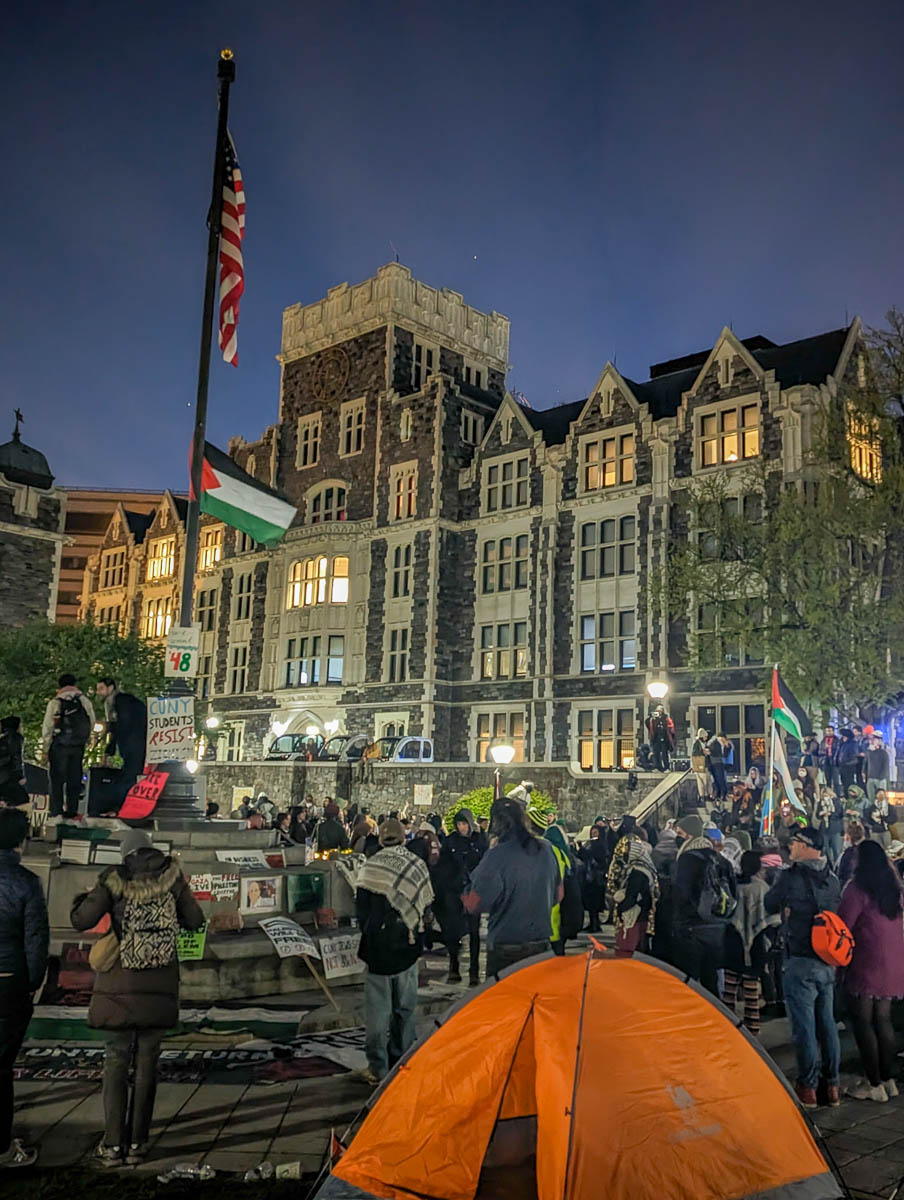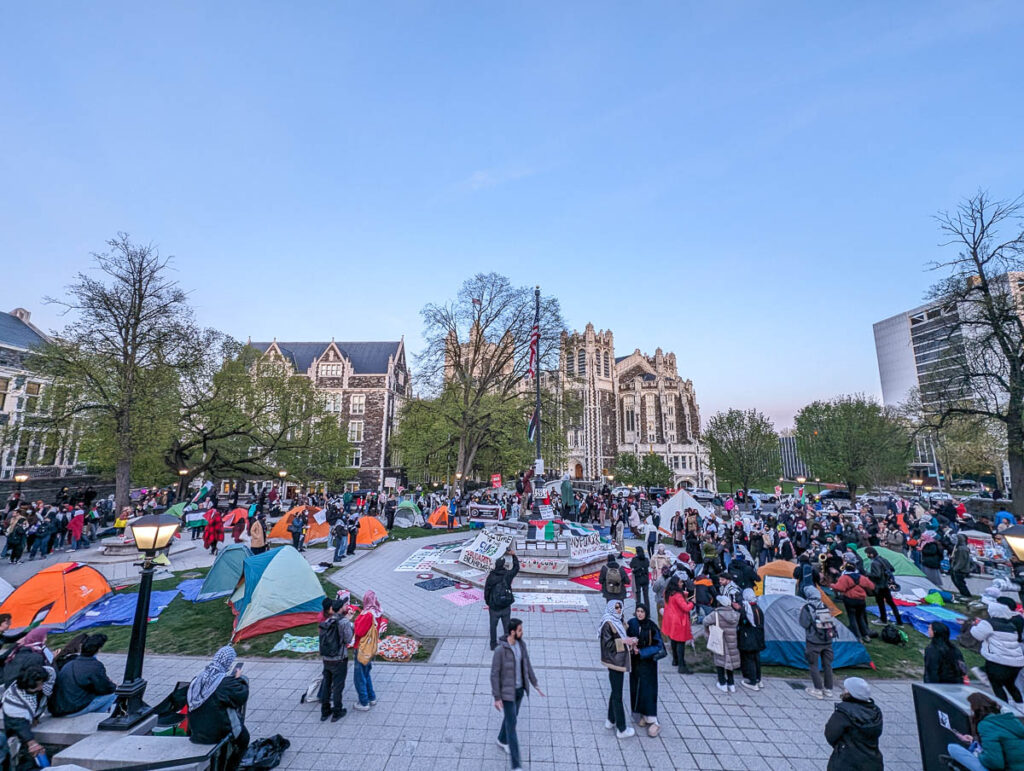By Anonymous
“One begins to wonder whether societies do not make a kind of Faustian pact when they set up universities: they ask them to serve various purposes, but if they are to be given the intellectual freedom necessary to serve those purposes properly, they will always tend to exceed or subvert those purposes.”
Stefan Collini[1]
In spring 2024, at the height of the encampment movement sweeping US universities, cultural critic and Assistant Professor of Jewish Thought Samuel P. Catlin published a scathing critique of university securitization and the spectacle of student protest, titled “The Campus Does Not Exist.”[2] In it, Catlin draws attention toward the campus as an ideological construction whereby scandal plays out in a bounded, contained, and fantastical series of carefully surveilled and widely projected theatrics. The campus, as such, does not exist as a geographical place, but rather as an epistemological map overlaying physical university campuses in order to produce ideal tropes and aesthetics of American higher education. Since the enclosure of a university’s campus is never actually closed in entirety, it is susceptible to the impurities of ‘outside agitators’ and must be policed by the state. Throughout the five days of the City University of New York’s (CUNY) Gaza solidarity encampment at the City College of New York (CCNY) in Harlem, New York, the spatial and conceptual boundaries of the campus as a trope were routinely challenged and rebuked by a diverse coalition of university students, alumni, faculty, workers, political allies, and Harlem community members. Through this collective refusal to reproduce the campus as a materially and ideologically bounded unit, participants in the CUNY solidarity encampment attempted to construct an alternative vision of CCNY’s placement in liberatory struggles against colonization and capitalist exploitation at local and international scales.
From the moment of the camp’s establishment to its violent destruction by the New York Police Department at the behest of CUNY’s administration, we spent our days and nights eating, sleeping, working, and learning within the encampment as active participants. Our observations and conversations with other encampment interlocutors were not recorded since we took part in the movement as comrades rather than as researchers. We report on these observations and conversations because we believe that valuable insights can be gleaned from our ethnographic experiences. In its brief window of existence, the encampment repeatedly faced crises of varying scales and complexities that were overcome through strategic pivoting and ingenuity. In focusing on the encampment as a critical event, built up to after several months of nation-wide and global protests articulating anti-imperialist demands for CUNY’s permanent divestment from Israel, our aim is to demonstrate how issues of spatial orientation and placemaking in campus activist movements are addressed through interpersonal acts of solidarity building. These “forms of engagement” that place participants into “contact and conflict with the organizational and administrative logics” of CCNY serve as epistemic grounds that drive social change.[3] Through this analytic framing, we situate the activist ethnographer as one conduit through which local struggles and tactics can be connected to broader political movements. In turn, ethnographic analyses can be used to provide visionary direction to existing theorizations in novel and practical ways, as anthropologist Biao Xiang[4] has argued for. As such, we use this piece to reflect on the encampment’s strategic nuances while simultaneously reaffirming its demands for full institutional divestment from the apartheid Israeli regime and the demilitarization of public university grounds.[5]
CCNY’s status as a public university posed numerous challenges for organizers and the police alike. Founded in 1847 as the first free public institution of higher education in the United States, CCNY’s neo-gothic campus is an open plan which melts into the neighborhood along its edges, sitting on a hill overlooking St. Nicholas Avenue. A wide accessway runs through the university – a street accessible to morning joggers and drifting tourists. The encampment began in the middle of the week, just before classes resumed for spring break. Orange and green tents were put up in the lawn across from Shephard Hall, a stone and terracotta building that works overtime as a “flexible event space.” Tour guides lined their guests up across from the encampment, out of earshot, puzzled by the teeming tarpaulin village that had sprung in the shadow of a cathedral. We would eventually watch neighbors and visitors from the area stuck outside as the NYPD dropped 15-gauge steel barricades. They clattered against the pavement, rendering public access impossible, becoming strategic choke points for later kettling. Imperceptible from a few blocks away, these silver barricades camouflaged the architectural challenge unique to CCNY, the neoliberal question of yesteryears: how does one make a public university private?
The actions taken by CUNY’s administrative body – which were enforced through their ‘public safety team’ – attempted to consolidate university activism solely to CCNY students and faculty by limiting building access to CCNY ID bearers, isolating CCNY from the city at large but also other CUNY affiliates – 25 colleges wide, spread across the city from Staten Island to the Bronx. Encampment participants were routinely surveilled through verification checks of their identification cards. Barring their access to university buildings meant facilities like restrooms and dining halls were rendered inaccessible. Although portable restrooms were eventually delivered after a multi-day negotiation process (though never maintained or emptied), encampment participants were able to circumvent facility restrictions through established communal ties to surrounding businesses and apartment residents. Nearby bodegas, cafes, and restaurants provided indiscriminate free restroom access alongside encouraging sentiments and verbal affirmations of solidarity to encampment members. Some stayed open all night to ensure that toilets and food were always accessible. Students would work in nearby cafes – continuing to study or prepare lectures as charging station and library access was revoked. A local food truck parked itself inside CCNY’s gates to serve fresh halal meals at no charge. Community members donated goods like sleeping bags and camping equipment for those less prepared. Bottled water deliveries alongside sanitation products were also delivered to the encampment by supporters.
These organic networks of comradery were forged through an understanding that any collective struggle for Palestinian solidarity within the imperial epicenter of the US required us to rethink the space of the university. In doubling down on the exclusion of ‘outsiders’ to access the campus, CUNY inadvertently created situational necessities whereby the encampment was forced to expand its operation beyond the scope of the college and, in turn, blurred the boundaries of the campus as such. Although there was a physical space designated as ‘the encampment perimeters’ located in the CCNY quad, the encampment was broadly recognized as an expansive and amorphous territory. It was a project that extended itself beyond the university grounds. Its collective maintenance through communal care and solidarity circumvented the college’s repeated attempts to fence in political imaginations and requisitioned a broader community – a coalition in training – to ensure it persists.

On April 30th, orders were given down by CUNY administration to vacate the quad immediately before the NYPD forcefully dismantled the encampment. We were told the police would arrive the following morning at an unspecified time. However, police units garbed in riot gear descended on CCNY that night. Heinously brutal arrests were documented within the quad as well as on the nearby streets of Harlem.[6] Given the encampment’s amorphous spatial boundaries, police harassed, beat, and arrested anyone outside of a building during the raid on suspicion that they were a collaborator. The next day, encampment organizers held a press conference organized along Amsterdam Avenue. The gates of the campus were sealed by the NYPD – no one could enter or exit. Several comrades were still being processed at the police precinct downtown. The press conference was quiet – no mics or speakers were allowed and the audience echoed each announcement, information rippling through the crowd one ring of voices at a time. In the background several police vans had already begun modifying the stone facade of CCNY’s walls, drilling in dual-dome CCTV cameras every six meters. The simultaneous launch of the press briefing and the installation of the cameras signaled a paranoia that beset both sides. CCNY had gotten far less coverage than the arrests at Columbia University the night before: its campus sweep was more like a wave of attacks that carried on for several hours. The sound of nervous drilling by the police suggested an urgency that was evident to anyone that was within a few miles of any encampment. The ideological space of the campus and its police enforcers were suspended in a bubble of mutual delegitimization – an assemblage of hench administrators, riot cops, and Zionist politicians.
This opening felt generous to those hoping to build international solidarity in the coming months. We wondered – would the university and its suspension of political order, from the McCarthyist pyramid of antisemitism charges ringing from Congress down to classrooms, to the imminent threat of strikes and shutdowns, situate the encampment as one among many strategies to spatialize an anti-imperialist politics. The encampment placed us in close quarters with the work done every day to reduce the imagination of a public university from one for critical study to vocational training, from experimental research to project management. The CUNY solidarity encampment was, foremost, an exercise in connecting international struggles against colonial repression by delegitimizing the spatial contours of confinement which characterize sites of resistance. It was a space of political education during Gaza, not an education after. It remained cocooned in the imperial core, yet in some regards, opened new channels. A phone was placed next to the mic over the course of multiple evenings as activists, some incarcerated, others closer to the place of war – dialed in. We sat around the lawn and listened.
For a brief five days, the college’s quad felt like it was ours – that it truly belonged to the working class people of New York City as a staging ground for organized defiance within the heart of empire. We used the space as a place of learning, communal care, and collective rage against a system that we are all implicated in. CUNY’s response of violent police repression is not shocking. It is part of a broader move by US university administrators beholden to bourgeois ideals and aesthetics of penal control in which ‘student well-being’ comes as surveillance equipment and riot gear rather than adequately usable classrooms, libraries, or communal spaces. The multifarious channels of solidarity that comprised an insurgent architecture of the encampment not only rebuked this aestheticization of securitization, but also sought to subvert the fantasy of the campus entirely.
Footnotes
[1] Collini, Stefan. 2012. What Are Universities For? Penguin Books.
[2] Catlin, Samuel P. 2024. “The Campus Does Not Exist: How Campus War is Made.” P&R Praxis. https://www.parapraxismagazine.com/articles/the-campus-does-not-exist
[3] Frampton et. al. 2006. “Social Movements/Social rResearch: Towards Political Activist Ethnography.” Sociology for Changing the World: Social Movements/Social Research. 1-17.
[4] Xiang, Biao. 2016. “Theory as Vision.” Anthropological Theory (16)2-3, 213-220.
[5] CUNY Solidarity Encampment. 2024. “CUNY 5 Demands for Palestine.” https://docs.google.com/document/d/1kYwpIlMhHAQWUbLwRv5h9_6dZwJPXEziIqhRvD5YI2M/edit
[6] Hill, Marc Lamont. 2024. “Drop the Charges Against the CUNY 22!” Al Jazeera. https://www.aljazeera.com/opinions/2024/6/24/drop-the-charges-against-the-cuny-22
References Cited
Catlin, Samuel P. 2024. “The Campus Does Not Exist: How Campus War is Made.” P&R Praxis. https://www.parapraxismagazine.com/articles/the-campus-does-not-exist
Collini, Stefan. 2012. What Are Universities For? Penguin Books.
CUNY Solidarity Encampment. 2024. “CUNY 5 Demands for Palestine.” https://docs.google.com/document/d/1kYwpIlMhHAQWUbLwRv5h9_6dZwJPXEziIqhRvD5YI2M/edit
Hill, Marc Lamont. 2024. “Drop the Charges Against the CUNY 22!” Al Jazeera. https://www.aljazeera.com/opinions/2024/6/24/drop-the-charges-against-the-cuny-22
Frampton et. al. 2006. “Social Movements/Social rResearch: Towards Political Activist Ethnography.” Sociology for Changing the World: Social Movements/Social Research. 1-17.
Xiang, Biao. 2016. “Theory as Vision.” Anthropological Theory (16)2-3, 213-220.
You may republish this article, either online and/or in print, under the Creative Commons CC BY-ND 4.0 license. We ask that you follow these simple guidelines to comply with the requirements of the license.
In short, you may not make edits beyond minor stylistic changes, and you must credit the author and note that the article was originally published on Home/Field.
